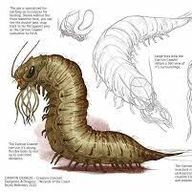The carrion crawler can move along walls,
ceilings and passages very quickly, using its many clawed
feet for traction. When attacking, the monster lashes out
with its 2' long tentacles, which produces a sticky secretion
that can paralyze for up to 2 hours and then kill them
with their bite. Carrion crawlers will continue to attack as
long as any of their opponents are unparalyzed.
Groups of crawlers attacking together will not fight in
unison, but will each concentrate on paralyzing as many
victims as they can. When seeking out prey, they rely
primarily on their keen senses of sight and smell. Clever
travelers have been known to fool an approaching carrion
crawler with a sight and smell illusion, thus gaining time
to make good their escape.
Terrain: Subterranean
Frequency: Uncommon
# Appearing: 1-6
The carrion crawler is a scavenger of subterranean
areas, feeding primarily upon carrion. When such food
becomes scarce, how-ever, it will attack and kill living
creatures. The crawler looks like a cross between a giant
green cutworm and a cephalopod. Like so many other
hybrid monsters, the car-rion crawler may well be the
result of genetic experimentation by a mad, evil wizard.
The monster's head, which is covered with a tough hide,
sprouts eight slender, writhing tentacles. The body of the
carrion crawler is not well protected. The monster is
accompanied by a rank, fetid odor which often gives
warning of its approach.
